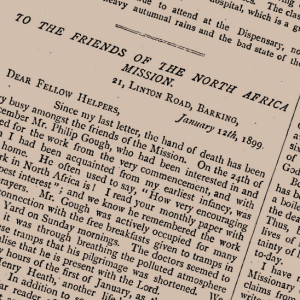Das meiste, was wir über Henry Heath wissen, verdanken wir Pickerings Chief Men among the Brethren;1 auch spätere Autoren (sofern sie Heath überhaupt erwähnen) schöpfen offenbar vorwiegend aus dieser Quelle.2 Dass in Chief Men ein falsches Todesjahr angegeben wird, habe ich in meinem Beitrag zum 200. Geburtstag Heaths bereits erwähnt; es hätte allerdings auch Pickering selbst schon auffallen können – immerhin waren die Letters of the Late Robert Cleaver Chapman, die Heaths Tod im Januar 1899 belegen, schon 1903 erschienen. Auf eine noch ältere und aufschlussreichere Quelle bin ich erst nach Verfassen meines Blogeintrags gestoßen; es handelt sich um einen Nachruf in der Zeitschrift North Africa vom Februar 1899.
 North Africa war das Organ der Anfang der 1880er Jahre gegründeten überkonfessionellen „North Africa Mission“,3 als deren Sekretär der Offene Bruder Edward Henry Glenny (1852–1926) fungierte.4 In seiner regelmäßigen Rubrik “To the Friends of the North Africa Mission” meldete er im Februar 1899 den Tod dreier Freunde der Mission: Philip Gough,5 Henry Heath und William Thomas Berger.6 Der Abschnitt über Heath lautet wie folgt:
North Africa war das Organ der Anfang der 1880er Jahre gegründeten überkonfessionellen „North Africa Mission“,3 als deren Sekretär der Offene Bruder Edward Henry Glenny (1852–1926) fungierte.4 In seiner regelmäßigen Rubrik “To the Friends of the North Africa Mission” meldete er im Februar 1899 den Tod dreier Freunde der Mission: Philip Gough,5 Henry Heath und William Thomas Berger.6 Der Abschnitt über Heath lautet wie folgt:
In the early hours of the first of January, as the New Year broke, Mr. Henry Heath, another life-long personal friend, reached home. In addition to sometimes helping financially, he was a regular reader of our paper, or it was read to him, and we may rest assured that the work was borne up before the Master whom he loved. He was a devoted, gifted, and eminent servant of Christ, but being very modest and retiring, was not so widely known as he otherwise might have been, though probably a considerable number of our readers may have known him. He was born in the year 1815, and converted early in life. At the age of nineteen he had a serious illness, and it was feared he might die of consumption, but the passage of Scripture, “I shall not die, but live and declare the works of the Lord,” was strongly impressed upon his mind. He was at first a schoolmaster, and then was associated with Mr. Robert Chapman, of Barnstaple, in Christian work. In 1841 he went to labour in Spain, and was in Malaga and Gibraltar for over a year at a time when work in Spain was very much more difficult than at present. He kept up his Spanish reading, though he did not return to that country again. In 1848 he was married, and entered upon Christian work at Hackney, and made this his centre of life and service till 1869. His tall, commanding figure, he must have stood 6 feet 2 or 3 inches, impressed itself vividly on my infant mind; he had an eagle eye, and his face was grave and serious, though it not infrequently relaxed into a pleasant smile. I owe much to his prayers, his holy example, and his calm faith, and now, after sixty or seventy years of service, he has reached home. He was buried at Woolpit, where he resided for the last thirty years, though during the last five years he had moved about rather more.
I was commissioned by members of Mr. Heath’s family to inform Mr. W. T. Berger, of Cannes, of his decease, as they had been closely associated in Christian work at Hackney; but on January 9th, before my letter could reach him, he, too, was called to the presence of the Master.7
Die Beschreibung von Heaths Charakter (“very modest and retiring”) und seinen wichtigsten Lebensstationen stimmt durchaus mit dem Bericht in Chief Men among the Brethren überein; eine ganze Reihe von Informationen sind jedoch völlig neu. Ich fasse sie stichwortartig zusammen:
- frühe Bekehrung
- lebensbedrohliche Krankheit im Alter von 19 Jahren
- Missionseinsatz in Spanien 1841/428
- Heirat 18489
- Zusammenarbeit mit William Thomas Berger in Hackney10
- Unterstützung der „North Africa Mission“
- Reisetätigkeit in den letzten fünf Lebensjahren
Alles dies war offenbar auch „C. J. H.“, dem Verfasser der Heath-Biografie in Chief Men among the Brethren, nicht bekannt – andernfalls hätte er sicher zumindest einiges davon erwähnt. Auch die spätere Brüdergeschichtsschreibung scheint Glennys Nachruf nicht verarbeitet zu haben, sodass er als veritable (wenn auch kleine) Entdeckung gelten kann.